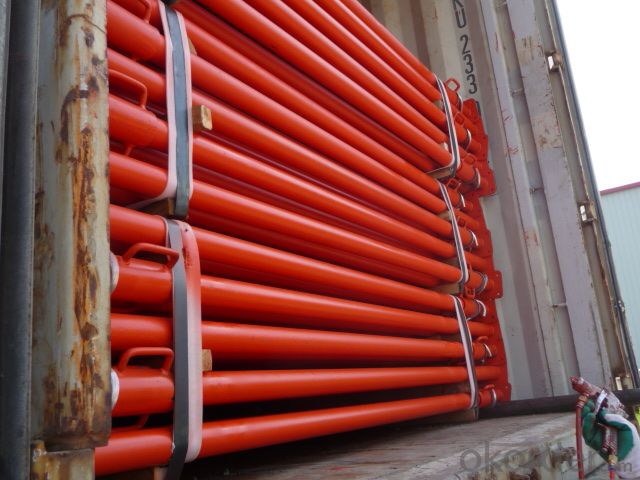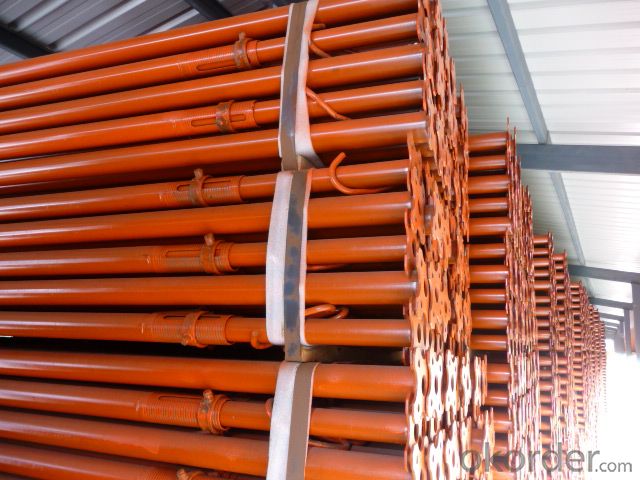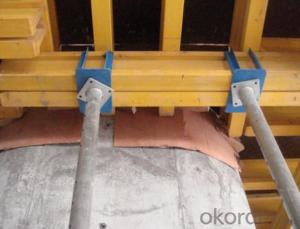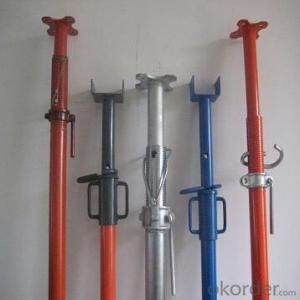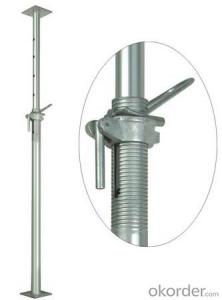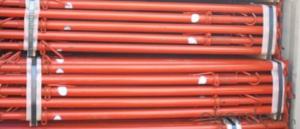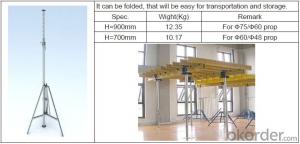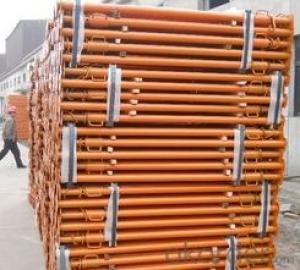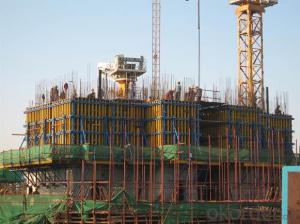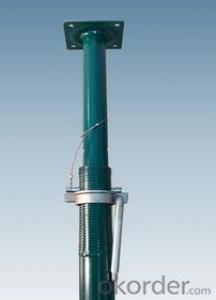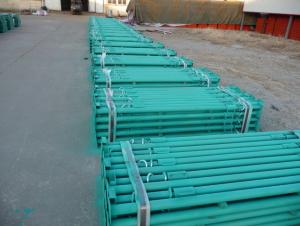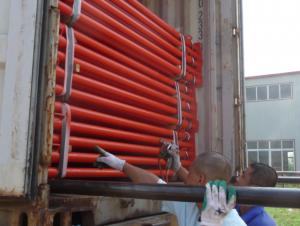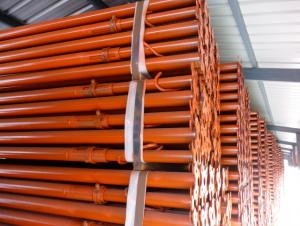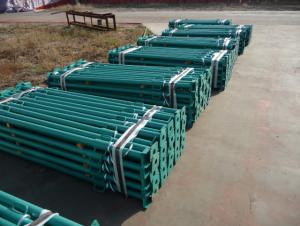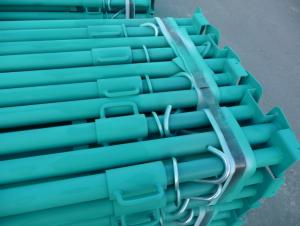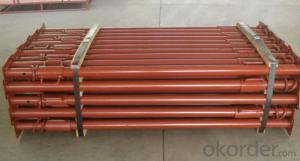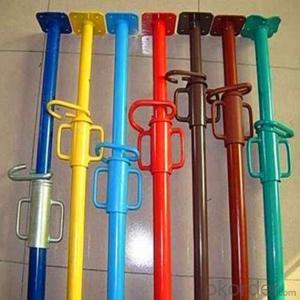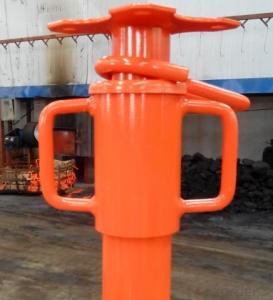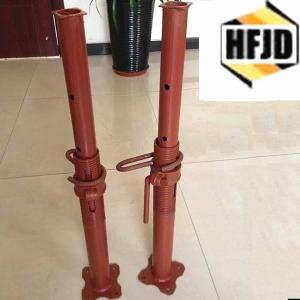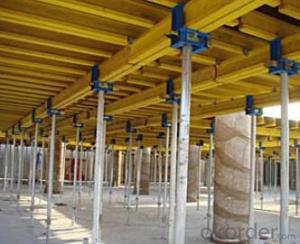Frame Scaffolding System, Astm Scaffolding pipe ,H Frame Scaffolding
- Loading Port:
- China Main Port
- Payment Terms:
- TT or LC
- Min Order Qty:
- 1000 Set/Sets pc
- Supply Capability:
- 10000 pc/month
OKorder Service Pledge
OKorder Financial Service
You Might Also Like
Quick Details
Place of Origin: Tianjin, China (Mainland)
- Model Number: SD1700/1930CGSP
Place of Origin: China (Mainland)
Type: Scaffolding Parts
Scaffolding Part Type: Scaffolding Props
Color: blue/green/red/brown
Height: 1700/1930mm
Steel Pipe Size: 25/42
Coated: Painted;Pre-Galvanized; Electro Galvanized
Material grade: Q195-Q235
Package: Bundles or in Bulk
Certification: ISO9001:2008

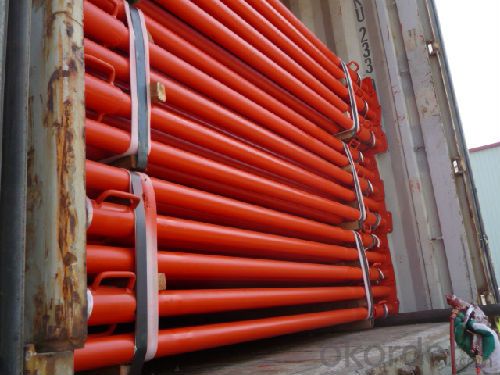
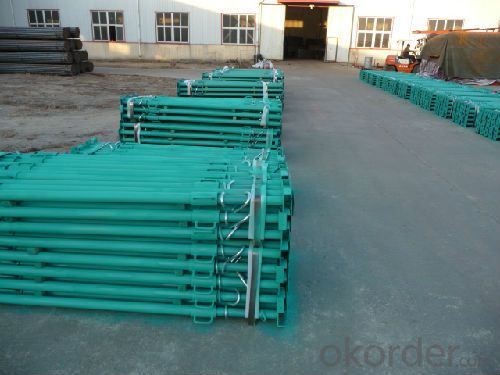
Packaging & Delivery
| Packaging Details: | 1- Frame scaffolding system is packed in bundle and wrapped with iron bar . 2- Usually , one 40HQ container can load 300-600 set of props , |
|---|---|
| Delivery Detail: | 40days |
Specifications
Frame scaffolding system is easy to assemble and dismantle which can help to save your time , energy and cost .
Product Description
astm scaffolding pipe
A- An adjustable steel prop including inner tube, Outer tube , prop nut ,prop pin , base plate and top plate
B- Adjustable steel prop can be adjusted to any length within its range which is convenient for using
C- Adjustable steel prop is easy to assemble and dismantle which can help to save your time , energy and cost .
D-We have several kinds of adjustable steel prop which are Middle East type adjustable steel prop , Spanish adjustable steel prop ,and Italian type adjustable steel prop . They are popular in Africa , South America , Middle east etc.
E-Adjustable steel prop is for supporting concrete slab , beam , timber and formwork which is strong and reliable for interior building construction .
F- we can weld the flat plate or the flower plate, or U-head plate , or fork plate at the top of the adjustable steel prop as your request .
astm scaffolding pipe
- Q: Can steel props be used in supporting temporary sound systems?
- Yes, steel props can be used in supporting temporary sound systems. Steel props are commonly used in construction to provide temporary support to structures, and they can also be utilized to ensure stability and safety for temporary sound systems. Steel props offer strength and stability, making them suitable for handling the weight and vibrations associated with sound equipment. Additionally, their adjustable nature allows for easy customization according to the specific requirements of the sound system setup.
- Q: Can steel props be used in supporting temporary formwork systems?
- Yes, steel props can be used in supporting temporary formwork systems. Steel props are commonly used in construction projects to provide support to temporary structures such as formwork systems. They are strong and durable, capable of withstanding heavy loads and providing stability to the formwork. Steel props are adjustable in height, allowing for flexibility in supporting different formwork heights and configurations. Additionally, they can be easily installed, dismantled, and reused, making them a cost-effective solution for temporary formwork support.
- Q: Are steel props suitable for supporting slabs or decks?
- Steel props, also referred to as adjustable steel props or scaffolding props, offer a suitable option for the support of slabs or decks. These props, widely utilized in construction, serve the purpose of temporarily supporting various structures, including slabs and decks. Their design enables effortless height adjustment and ensures stability and the capacity to bear loads. Constructed from top-notch steel, steel props guarantee strength and durability. Their applications encompass a wide range of uses, such as supporting concrete slabs throughout the construction process, providing temporary support during renovations or repairs, or supporting temporary decking for events or construction sites. In essence, steel props present a dependable and adaptable solution for the support of slabs or decks.
- Q: What are the environmental impacts of using steel props?
- Several environmental impacts can arise from the use of steel props in construction projects. To begin with, the extraction of iron ore, a non-renewable resource, is necessary for steel production. This mining process can result in the destruction of habitats, erosion of soil, and pollution of water. Moreover, the production of steel requires substantial amounts of energy, often derived from fossil fuels, which contributes to the emission of greenhouse gases and climate change. Furthermore, the manufacturing process of steel props involves the use of various chemicals and emissions that can have harmful effects on the quality of air and water. The release of pollutants like carbon monoxide, sulfur dioxide, and nitrogen oxide during steel production can contribute to air pollution and respiratory issues for nearby communities. In addition, steel props have a significant transportation impact due to their weight and size. Their transportation from manufacturing facilities to construction sites often involves the use of large trucks or shipping containers, which consume fossil fuels and contribute to carbon emissions. Moreover, the disposal of steel props at the end of their lifespan can present environmental challenges. If not properly managed and recycled, these props may end up in landfills, taking up valuable space and potentially contaminating the soil and groundwater. However, it is important to acknowledge that steel props offer several advantages in construction, such as their strength and durability, which contribute to safer and more efficient building practices. Additionally, the steel industry is making efforts to reduce its environmental impact through energy-efficient manufacturing processes, recycling initiatives, and the development of greener technologies. Overall, while steel props do have environmental impacts throughout their lifecycle, their usage can be mitigated through responsible sourcing, efficient manufacturing processes, recycling, and proper disposal methods.
- Q: What are the advantages of using a steel prop?
- There are several advantages to using a steel prop in construction projects. Firstly, steel props are known for their exceptional strength and durability. They can withstand heavy loads and provide reliable support for various structures. This strength allows for the safe construction of buildings and other structures, ensuring the safety of workers and the longevity of the project. Additionally, steel props are highly adjustable and versatile. They can be easily extended or retracted to fit the required height, making them suitable for a wide range of applications. This flexibility allows for efficient and precise construction, as the props can be adjusted to match specific project requirements. Steel props also offer excellent stability and load-bearing capacity. They provide a solid foundation for different types of structures, ensuring stability and preventing any potential collapse or accidents during construction. This stability is particularly crucial for projects that involve heavy loads or unique architectural designs. Furthermore, steel props are cost-effective. Their durability and reusable nature make them a cost-efficient option, as they can be used for multiple projects over an extended period. This reduces the need for frequent replacements or repairs, ultimately saving both time and money. Lastly, steel props are relatively easy to handle and install. They are lightweight and require minimal effort to set up and dismantle, streamlining the construction process and reducing labor costs. This ease of use makes steel props a popular choice among construction professionals. In conclusion, the advantages of using steel props in construction projects include their strength, adjustability, stability, cost-effectiveness, and ease of use. These qualities make them an excellent choice for ensuring safety, efficiency, and successful completion of various construction projects.
- Q: What are the common causes of failure of steel props?
- There are several common causes of failure of steel props, which are temporary support structures used in construction projects. These causes can be categorized into three main factors: design, material, and usage. Firstly, design flaws can contribute to the failure of steel props. Inadequate design calculations, such as underestimating the load-bearing capacity or the height required for the prop, can lead to structural failure. Insufficient bracing or improper placement of props can also result in instability and collapse. Therefore, it is crucial to ensure that the design of steel props is thorough, taking into account the specific requirements and conditions of the construction project. Secondly, the quality and material of the steel props themselves can play a significant role in their failure. Poor quality materials or manufacturing defects can weaken the structural integrity of the props, making them more susceptible to failure. For instance, if the steel used in the props is of low quality or has not been properly treated or coated for corrosion resistance, it may lead to premature deterioration and subsequent failure. Regular inspections and maintenance are essential to identify any potential material-related issues and prevent failures. Lastly, improper usage and handling of steel props can also contribute to their failure. Overloading the props beyond their rated capacity is a common cause of failure. This can occur when contractors or workers fail to follow the guidelines and specifications provided by the manufacturer. Additionally, mishandling during transportation, assembly, or disassembly can lead to damage or misalignment of the props, compromising their structural integrity and potentially causing failure. To mitigate the risk of failure, it is essential to ensure proper design, use high-quality materials, and follow the manufacturer's guidelines for installation and usage. Regular inspections, maintenance, and training of construction workers on proper handling and usage techniques are also crucial to prevent the failure of steel props.
- Q: Can steel props be used in the construction of underground parking structures?
- Yes, steel props can be used in the construction of underground parking structures. Steel props provide excellent structural support and stability, making them suitable for withstanding the heavy loads and pressures typically found in underground parking structures. Additionally, steel props can be easily adjusted and installed, allowing for flexibility during construction and ensuring the safety and durability of the parking structure.
- Q: What are the common accessories used for securing steel props to existing structures?
- Some common accessories used for securing steel props to existing structures include: 1. Prop heads: These are typically metal plates or brackets that are used to fix the top end of the steel props to the structure. They provide a stable and secure connection point. 2. Prop base plates: These are flat metal plates that are placed at the bottom end of the steel props to distribute the load evenly and prevent the props from sinking into the ground. Base plates also provide stability and prevent the props from tipping over. 3. Prop pins: These are metal pins or bolts that are used to secure the prop heads and base plates to the existing structure. They ensure a strong and reliable connection between the props and the structure. 4. Prop connectors: These are metal connectors or couplers that are used to join multiple steel props together to create longer support systems. They allow for adjustable height and provide additional stability when multiple props are used in a row. 5. Prop wedges: These are small metal wedges that are inserted between the prop heads and the structure to provide a tight fit and prevent any movement or slippage. They help to secure the props in place and ensure they remain stable during use. 6. Prop braces: These are additional support beams or struts that are used to reinforce the steel props and increase their load-bearing capacity. Braces are particularly useful when the props are supporting heavy loads or spanning long distances. Overall, these accessories play a crucial role in securing steel props to existing structures, ensuring safety, stability, and effective load distribution. They are designed to withstand various forces and conditions, providing a reliable solution for temporary or permanent support systems.
- Q: Are steel props environmentally friendly?
- Steel props are not considered environmentally friendly due to their high carbon footprint and energy-intensive production process. Steel production requires significant amounts of energy, releases large amounts of greenhouse gases, and contributes to deforestation and habitat destruction. Additionally, steel props are non-biodegradable, meaning they do not decompose and can contribute to waste accumulation if not properly recycled.
- Q: How do you ensure stability on uneven or sloped surfaces when using steel props?
- When using steel props on uneven or sloped surfaces, there are several measures you can take to ensure stability: 1. Assess the surface: Before setting up the steel props, assess the uneven or sloped surface thoroughly. Identify any irregularities, bumps, or slopes that could affect stability. This will help you plan the placement of the props accordingly. 2. Use adjustable props: Opt for adjustable steel props that can be extended or shortened as per the requirements of the uneven or sloped surface. This will allow you to maintain a level and stable support system. 3. Ensure proper base support: Create a stable base by using strong and level materials such as timber, concrete blocks, or steel plates. Place these underneath the steel props to provide a solid foundation, minimizing the impact of the uneven or sloped surface. 4. Wedge props: In cases where the surface is sloped or uneven, use wedges to level the steel props. Place the wedges under the base of the props to compensate for the slope and achieve stability. Ensure the wedges are securely positioned to prevent any movement. 5. Secure props to adjacent structures: If possible, anchor the steel props to adjacent structures, such as walls or columns, to enhance stability. This can be done by using clamps or braces to hold the props firmly in place. 6. Regular inspections: Conduct regular inspections to check the stability of the steel props during the construction process. Look for any signs of movement or shifting and promptly address any issues to maintain stability. 7. Seek professional advice: If you are unsure about the stability of steel props on uneven or sloped surfaces, seek advice from a structural engineer or construction professional. They can provide specific guidance and recommendations based on the unique conditions of your project. By following these measures, you can ensure stability when using steel props on uneven or sloped surfaces, minimizing the risk of accidents or structural failures.
Send your message to us
Frame Scaffolding System, Astm Scaffolding pipe ,H Frame Scaffolding
- Loading Port:
- China Main Port
- Payment Terms:
- TT or LC
- Min Order Qty:
- 1000 Set/Sets pc
- Supply Capability:
- 10000 pc/month
OKorder Service Pledge
OKorder Financial Service
Similar products
Hot products
Hot Searches
Related keywords




